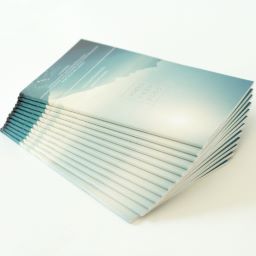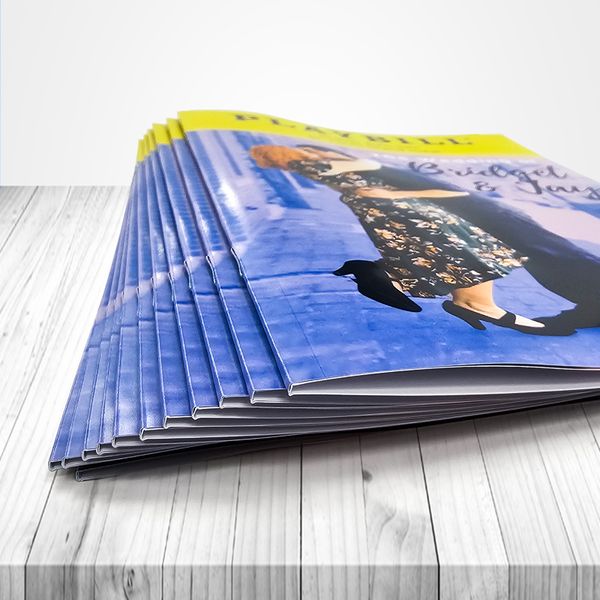10 Innovative Ways Booklet Printing Is Revolutionizing Promotional Campaigns
10 Innovative Ways Booklet Printing Is Revolutionizing Promotional Campaigns
Blog Article
The Important Guide to Recognizing Pamphlet Printing Options and Techniques
The procedure of brochure printing entails multiple considerations that can considerably affect the final product. From picking the proper layout and size to recognizing the subtleties of binding methods, each choice plays an important function. Furthermore, variables such as paper stock and printing techniques more affect the performance of the booklet. As one navigates these choices, it comes to be imperative to understand how they adjoin and what that implies for the total result.
Comprehending Brochure Sizes and styles
When taking into consideration brochure printing, understanding the various formats and sizes offered is important for attaining the desired presentation. Booklets can be generated in various layouts, including saddle-stitched, spiral-bound, and perfect-bound, each offering distinct benefits. Typical dimensions range from standard letter (8.5 x 11 inches) to smaller sized choices like A5 (5.8 x 8.3 inches), enabling for versatility based upon web content and target audience.Selecting the suitable size can affect both the format and viewers interaction. Bigger sizes may match aesthetically driven content, while smaller sized layouts might be much more portable and easy to use. Additionally, the number of pages affects the selection of binding method, as thicker booklets might call for tougher bindings. Ultimately, understanding these facets enables a much more customized technique, guaranteeing that the last product lines up with the intended message and visual, improving the general performance of the communication.
Picking the Right Paper Stock
Binding Methods: Options and Considerations
When it concerns binding techniques for booklets, numerous alternatives are offered, each with distinct advantages. Saddle stitch binding uses an affordable option for thinner pamphlets, while perfect binding techniques offer a more refined look for thicker publications. Wire-O binding attracts attention for its resilience and convenience of use, making it excellent for documents that require versatility.
Saddle Stitch Binding
Saddle stitch binding supplies a practical and affordable solution for setting up pamphlets, making it a popular option among publishers and businesses. This binding technique includes folding sheets of paper in fifty percent and stapling them along the fold line, producing a neat and organized appearance. Normally appropriate for brochures with a lower web page count, saddle sewing is suitable for publications, sales brochures, and instructional products. The simplicity of this method enables for fast manufacturing and is typically favored for brief runs or promotional items. It is necessary to keep in mind that saddle stitch binding might not be ideal for thicker pamphlets, as the spinal column might not hold up under increased weight. Generally, it stays a reputable choice for several printing projects.
Perfect Binding Techniques
Perfect binding is an extensively used method that offers a refined and expert finish to booklets and magazines. This method entails gluing the web pages together at the back utilizing a strong adhesive, permitting a tidy side and the capacity to hold a bigger number of pages contrasted to saddle sewing. Perfect binding is especially suitable for thicker brochures, such as catalogs and yearly records, where a tough, flat spinal column is preferred. Additionally, it provides the option for a printed cover that can be designed to improve visual appeal. Considerations such as page matter, paper weight, and the meant usage of the pamphlet must be taken into account, as they can influence toughness and overall high quality.
Wire-O Binding Alternatives
Wire-O binding, recognized for its toughness and versatility, uses an outstanding alternative for booklets that require easy web page turning and an expert look. This binding method utilizes a series of steel loopholes that hold pages safely, permitting them to lie level when open. It is especially ideal for catalogs, presentations, and manuals because of its durable nature. Wire-O binding is available in numerous colors and sizes, fitting various web page counts and thicknesses. Additionally, it permits the inclusion of tabs and covers, boosting the brochure's general visual. Considerations for Wire-O binding consist of the selection of cable color, the dimension of the loops, and the degree of customization preferred, every one of which can greatly influence the last product's appearance and functionality.
Digital vs. Offset Printing: Which Is Best for You?
When choosing a printing method for pamphlets, understanding the distinctions in between electronic and offset printing is important. Digital printing uses contemporary innovation to produce top notch prints quickly and cost effectively, making it ideal for short runs or jobs needing fast turnaround times. It enables customization, giving the capacity to publish on-demand with marginal waste.In comparison, offset printing is a conventional approach that masters creating large amounts with consistent top quality. It involves moving ink from a plate to a rubber blanket, then to the paper, which results in lively shades and precise details. Offset printing normally needs longer arrangement times and is extra economical for larger volumes.Ultimately, the choice between digital and counter printing depends on job requirements, spending plan, and wanted amount. For tiny, time-sensitive tasks, electronic could be the ideal selection, while balanced out may be more suitable for bigger, high-quality productions.

Designing Your Pamphlet: Tips and Finest Practices
When making a brochure, careful attention to layout, typeface choice, and color usage can considerably boost its effectiveness. A well-structured format guides the reader's eye, while appropriate font styles guarantee readability and communicate the preferred tone. In addition, effective use of shade can stimulate emotions and highlight crucial info, making the total style more impactful.
Selecting the Right Format
Exactly how can one efficiently select the right format for a pamphlet? It is vital to review the pamphlet's purpose and target audience. A tidy, organized design enhances readability and engagement. Making use of a grid system can help in aligning components continually, creating a specialist appearance. In addition, including aesthetic power structure through differing dimensions and positionings of images and text can see here now direct the viewers's eye and highlight vital details. It is likewise essential to leave sufficient white area, which prevents overcrowding and permits much better focus. Finally, checking various layouts via mock-ups can offer insight right into just how the style does in real-world situations, guaranteeing that the last product fulfills both useful and aesthetic demands.
Choosing Proper Typefaces
A well-chosen font style can significantly boost the general design of a booklet, complementing the layout and enhancing the material's message. The choice of typefaces should think about readability, specifically for body text, as it assures the information comes to all readers. Sans-serif typefaces are typically preferred for electronic layouts, while serif typefaces can offer a traditional feeling in published products. It's recommended to limit font choices to two or three to preserve aesthetic comprehensibility. Additionally, font dimension plays a vital role; headings must be distinct yet not overwhelming, while body message should fit for reading. When picking fonts, positioning with the brochure's motif and target market is vital for efficient interaction and visual charm.
Effective Use Color
Color works as an effective device in pamphlet design, shaping understandings and directing visitor feelings. It can evoke sensations of count on, exhilaration, or peace, relying on the hues picked. Designers must take into consideration shade concept concepts, ensuring that the chosen scheme lines up with the brochure's message and target audience. As an example, utilizing cozy shades like red and orange can create necessity, while cooler tones like blue and green foster tranquility.Additionally, comparison plays an essential duty; complementary shades can improve readability and visual charm. Consistency in color usage across web pages better strengthens brand identification and communication. Inevitably, efficient color application not only records focus but likewise strengthens the pamphlet's function, making it an essential aspect of successful layout.
Completing Touches: Coatings and Special Results
While many consider the web content and design of a brochure one of the most important elements, the ending up touches, such as finishes and special results, play a vital duty in boosting its general charm. Coatings can give security and toughness, making certain that the brochure withstands damage. Matte finishes supply an advanced, non-reflective surface, while shiny coverings can make colors show up more distinctive and lively. Special impacts, like embossing or aluminum foil marking, add a tactile measurement that can produce a memorable perception. These methods can highlight particular locations, drawing focus to visit the website crucial details or producing aesthetic interest. Furthermore, UV layer can supply a high-shine finish that raises the general look.Together, these completing touches not just boost the booklet's visual however additionally communicate expertise and attention to detail, eventually leaving a long-term effect on the viewers.
Expense Considerations for Brochure Printing
Understanding the different expense factors to consider for pamphlet printing is vital for organizations and services aiming to optimize their spending plans. Trick variables influencing expenses consist of the option of binding, paper, and ink approaches. Better products, such as superior paper or specialized inks, normally boost the total cost. Additionally, the dimension and web page count of the pamphlet play a substantial function; bigger brochures call for more sources and time to produce.Another crucial consideration is the printing method, whether digital or countered, as each has its own Recommended Reading rates structure and viability for different quantities. Organizations should likewise consider design prices, which can differ based upon complexity and making use of specialist services. Eventually, delivery and handling costs can contribute to the overall, specifically for huge orders. By assessing these components, organizations can make educated choices that align with their financial abilities while accomplishing the wanted top quality in their published materials.
Often Asked Concerns
What Are the Environmental Influences of Pamphlet Printing?
The environmental effects of booklet printing consist of logging from paper production, carbon emissions from transportation, and waste generation from discarded materials - Booklet Printing. Sustainable methods, such as utilizing recycled paper and green inks, can minimize these effects
Exactly How Can I Ensure Shade Accuracy in My Booklet?
To ensure shade precision in a brochure, one ought to make use of calibrated monitors, utilize professional shade profiles, carry out test prints, and select premium printing solutions that offer shade matching and proofing choices for ideal results.
What Is the Normal Turnaround Time for Brochure Printing?
The normal turnaround time for booklet printing differs depending upon the complexity and amount - Booklet Printing. Usually, it ranges from a couple of days to two weeks, affected by factors such as printing methods and completing demands
Are There Minimum Order Quantities for Brochure Printing?

Can I Publish Brochures in Multiple Languages?
Publishing pamphlets in several languages is possible. Several printing solutions supply alternatives for multilingual or bilingual designs, allowing for effective interaction. Careful planning warranties that design components accommodate various languages without endangering readability or aesthetics. In addition, elements such as paper stock and printing techniques more influence the efficiency of the pamphlet. When taking into consideration booklet printing, recognizing the different layouts and sizes offered is vital for attaining the wanted discussion. When choosing a printing method for booklets, understanding the distinctions in between electronic and balance out printing is vital. Additionally, the dimension and page count of the pamphlet play a significant duty; larger brochures need more resources and time to produce.Another vital consideration is the printing strategy, whether electronic or offset, as each has its very own rates framework and suitability for different amounts. The ecological effects of pamphlet printing include deforestation from paper production, carbon emissions from transport, and waste generation from discarded products.
Report this page